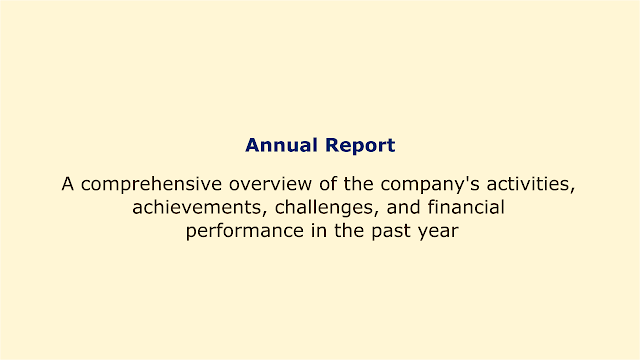 |
| Image: Moneybestpal.com |
An annual report is one of the most significant papers that a company can create. An annual report provides a thorough assessment of the business's operations, successes, setbacks, and financial performance over the previous year.
It acts as a medium for communication so that all parties involved, including customers, employees, regulators, and the general public, are aware of the company's vision, mission, values, goals, strategies, and outcomes.
An annual report typically consists of several sections, such as:
A company's annual report can demonstrate its brand identity and reputation in addition to being a necessary regulatory requirement for some businesses. As a result, it's crucial to create yearly reports that are appealing to the target audience and are clear, succinct, accurate, and engaging.
Some tips for designing an annual report are:
An annual report typically consists of several sections, such as:
- Letter from the CEO or Chairperson: A personal statement from the company's senior executive is provided in this section, outlining the major accomplishments, difficulties, and opportunities of the previous year as well as the outlook for the next year.
- Business Overview: A brief overview of the company's history, goods or services, target markets, rivals, and organizational structure is provided in this part. A synopsis of the organization's vision, mission, values, and objectives may also be included.
- Operational Review: This section provides information on the operation of the company's many divisions or business sectors, including sales, marketing, production, research and development, customer support, etc. Also, it could contain details about the debuts of new products, alliances, purchases, awards, or other forms of recognition.
- Financial Review: The financial statements for the company—including the income statement, balance sheet, cash flow statement, and notes—are shown in this part. To further highlight the financial trends and performance indicators, it might additionally incorporate financial ratios, graphs, charts, or tables.
- Corporate Governance: This section outlines the company's governance structure and procedures, including the board of directors, committees, policies, conduct codes, risk management, internal controls, audits, compliance, etc. Additionally, it might contain data on CEO pay, shareholder rights, social responsibility, environmental effects, diversity and inclusion, etc.
- Appendices: The annual report's readers will find extra material in this part that may be pertinent or helpful. For instance, a dictionary of words, a list of subsidiaries, a ranking of the principal clients or vendors, a list of honors or distinctions, etc.
A company's annual report can demonstrate its brand identity and reputation in addition to being a necessary regulatory requirement for some businesses. As a result, it's crucial to create yearly reports that are appealing to the target audience and are clear, succinct, accurate, and engaging.
Some tips for designing an annual report are:
- Use a consistent theme and style throughout the report that reflects the company's brand personality and values.
- Use headings and subheadings to organize the information and make it easy to scan and navigate.
- Use visuals such as photos, icons, illustrations, graphs, charts, or tables to complement the text and highlight the key points or data.
- Use colors, fonts, and white space to create contrast and hierarchy and enhance readability and aesthetics.
- Use storytelling techniques to convey the company's story and connect with the readers emotionally.
- Use testimonials, quotes, or case studies to showcase the company's impact and success stories.
- Use call-to-action buttons or links to direct the readers to more information or resources on the company's website or social media platforms.
